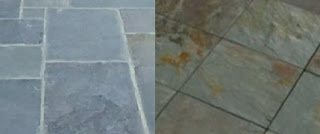 |
| Bluestone (left) vs. slate (right) |
The problem that plagued Rollow was quite simple: she didn't know enough about her topic to realize that, while slate is the scientifically-defined name of a type of metamorphic rock, "bluestone" is not. Instead, it's a commercial name, much like "flagstone" for paving companies or "granite" and "marble" for the people who sell kitchen countertops. Given Rollow's vague understanding of sedimentology and petrology, it comes as no surprise that she had difficulty in synthesizing a good answer. We'll try to help...
Slate is a metamorphic rock of medium grade (between phyllite and schist). It is characterized by fissility, a tendency to split into thin layers. This is because during metamorphism, tiny plate-shaped mineral grains form that are aligned parallel to each other. In the eastern U S A, bluestone is a well-cemented, i.e. hard, blue to dark gray sandstone found in much of the Hudson Valley. It splits into thin layers well-suited for flagstones and other paving stone. Slate is very fine-grained, while the sand-size grains of bluestone are more coarse. Note that "bluestone" is a commercial name applied to any grayish or blueish paving stone regardless of is origin. We have even seen it applied to limestone.
Not realizing that "bluestone" has no defined meaning, Delia waxed eloquent... based on her one resource. According to her,
"Bluestone is a feldspathic sandstone, composed of largely uniform rock particles deposited over a long period of time. Bluestone is a product of ocean or tidal sediments settling out of water which has since disappeared."
While the words are technically true, the juxtaposition of the third-grade science level of "a long period of time" and "water which has since disappeared" against the rather erudite term "feldspathic sandstone" is clear evidence that Rollow's environmental studies degree didn't include much earth science. She compounded her faulty information parroting job by "explaining" that,
"Slate is a sedimentary rock that is composed of hardened clay, or mica, particles. In the early stages of slate's composition, mica sediments were compacted and water was forced out of the clay, forming shale."
First, slate is not a sedimentary rock (it's metamorphic). Second, clay minerals and mica are not the same thing. Third, there's no such thing as those "mica sediments." And finally, Delia's understanding of the process of quarrying the two products is... lacking, resulting in the following:
"Slate... can be cut thinly enough that it will not be too heavy..."
In point of fact, slate isn't "cut thinly" to make roofing tiles; it separates into thin layers naturally because of its texture. But, then, our Dumbass of the Day didn't have the background to understand that. So why did she write this, anyway? Fifteen bucks, that's why...
SI - PETROLOGY
No comments:
Post a Comment